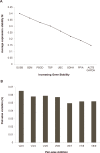Selection of reference gene expression in a schizophrenia brain cohort
- PMID: 20073568
- PMCID: PMC2950262
- DOI: 10.3109/00048670903393662
Selection of reference gene expression in a schizophrenia brain cohort
Abstract
Objective: In order to conduct postmortem human brain research into the neuropatho-logical basis of schizophrenia, it is critical to establish cohorts that are well-characterized and well-matched. The aim of the present study was therefore to determine if specimen characteristics including: diagnosis, age, postmortem interval (PMI), brain acidity (pH), and/or the agonal state of the subject at death related to RNA quality, and to determine the most appropriate reference gene mRNAs.
Methods: A matched cohort was selected of 74 subjects (schizophrenia/schizoaffective disorder, n = 37; controls, n = 37). Middle frontal gyrus tissue was pulverized, tissue pH was measured, RNA isolated for cDNA from each case, and RNA integrity number (RIN) measurements were assessed. Using quantitative reverse transcription-polymerase chain reaction, nine housekeeper genes were measured and a geomean calculated per case in each diagnostic group.
Results: The RINs were very good (mean = 7.3) and all nine housekeeper control genes were significantly correlated with RIN. Seven of nine housekeeper genes were also correlated with pH; two clinical variables, agonal state and duration of illness, did have an effect on some control mRNAs. No major impact of PMI or freezer time on housekeeper mRNAs was detected. The results show that people with schizophrenia had significantly less PPIA and SDHA mRNA and tended to have less GUSB and B2M mRNA, suggesting that these control genes may not be good candidates for normalization.
Conclusions: In the present cohort <10% variability in RINs was detected and the diagnostic groups were well matched overall. The cohort was adequately powered (0.80-0.90) to detect mRNA differences (25%) due to disease. The study suggests that multiple factors should be considered in mRNA expression studies of human brain tissues. When schizophrenia cases are adequately matched to control cases subtle differences in gene expression can be reliably detected.
Figures





Similar articles
-
Limited predictability of postmortem human brain tissue quality by RNA integrity numbers.J Neurochem. 2016 Jul;138(1):53-9. doi: 10.1111/jnc.13637. Epub 2016 May 12. J Neurochem. 2016. PMID: 27062510 Free PMC article.
-
Critical factors in gene expression in postmortem human brain: Focus on studies in schizophrenia.Biol Psychiatry. 2006 Sep 15;60(6):650-8. doi: 10.1016/j.biopsych.2006.06.019. Biol Psychiatry. 2006. PMID: 16997002
-
Mitochondrial-related gene expression changes are sensitive to agonal-pH state: implications for brain disorders.Mol Psychiatry. 2006 Jul;11(7):615, 663-79. doi: 10.1038/sj.mp.4001830. Epub 2006 Apr 25. Mol Psychiatry. 2006. PMID: 16636682 Free PMC article.
-
Tissue preparation and banking.Prog Brain Res. 2006;158:3-14. doi: 10.1016/S0079-6123(06)58001-X. Prog Brain Res. 2006. PMID: 17027689 Review.
-
Genetic neuropathology of schizophrenia: new approaches to an old question and new uses for postmortem human brains.Biol Psychiatry. 2011 Jan 15;69(2):140-5. doi: 10.1016/j.biopsych.2010.10.032. Biol Psychiatry. 2011. PMID: 21183009 Free PMC article. Review.
Cited by
-
Testosterone regulation of sex steroid-related mRNAs and dopamine-related mRNAs in adolescent male rat substantia nigra.BMC Neurosci. 2012 Aug 6;13:95. doi: 10.1186/1471-2202-13-95. BMC Neurosci. 2012. PMID: 22867132 Free PMC article.
-
Circular RNA biogenesis is decreased in postmortem cortical gray matter in schizophrenia and may alter the bioavailability of associated miRNA.Neuropsychopharmacology. 2019 May;44(6):1043-1054. doi: 10.1038/s41386-019-0348-1. Epub 2019 Feb 20. Neuropsychopharmacology. 2019. PMID: 30786269 Free PMC article.
-
Human Brain Region-Specific Alternative Splicing of TRPC3, the Type 3 Canonical Transient Receptor Potential Non-Selective Cation Channel.Cerebellum. 2019 Jun;18(3):536-543. doi: 10.1007/s12311-019-01026-4. Cerebellum. 2019. PMID: 30887370
-
Histological assessment of cerebellar granule cell layer in postmortem brain; a useful marker of tissue integrity?Cell Tissue Bank. 2012 Dec;13(4):521-7. doi: 10.1007/s10561-011-9265-1. Epub 2011 Jun 28. Cell Tissue Bank. 2012. PMID: 21710172 Free PMC article.
-
Promoter specific alterations of brain-derived neurotrophic factor mRNA in schizophrenia.Neuroscience. 2010 Sep 1;169(3):1071-84. doi: 10.1016/j.neuroscience.2010.05.037. Epub 2010 May 27. Neuroscience. 2010. PMID: 20553817 Free PMC article.
References
-
- Kleinman JE, Hyde TM, Herman MM. Methodological issues in the neuropathology of mental illness. In: Bloom FE, Kupfer DJ, editors. Psychopharmacology: The Fourth Generation of Progress. Raven Press, Ltd.; New York: 1995. pp. 859–864.
-
- Lewis DA. The human brain revisited: opportunities and challenges in postmortem studies of psychiatric disorders. Neuropsychopharmacology. 2002;26:143–54. - PubMed
-
- Ravid R, Van Zwieten EJ, Swaab DF. Brain banking and the human hypothalamus--factors to match for, pitfalls and potentials. Prog Brain Res. 1992;93:83–95. - PubMed
-
- Bahn S, Augood SJ, Ryan M, Standaert DG, Starkey M, Emson PC. Gene expression profiling in the post-mortem human brain--no cause for dismay. J Chem Neuroanat. 2001;22:79–94. - PubMed
-
- Bunney WE, Bunney BG, Vawter MP, Tomita H, Li J, Evans SJ, Choudary PV, Myers RM, Jones EG, Watson SJ, Akil H. Microarray technology: a review of new strategies to discover candidate vulnerability genes in psychiatric disorders. Am J Psychiatry. 2003;160:657–66. - PubMed
Publication types
MeSH terms
Substances
Grants and funding
LinkOut - more resources
Full Text Sources
Other Literature Sources
Medical
Research Materials
Miscellaneous

